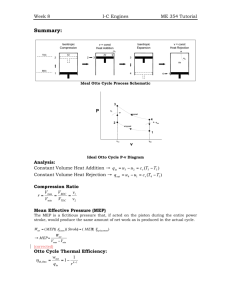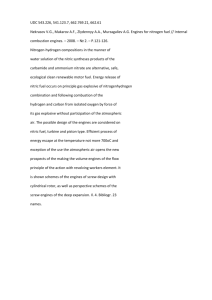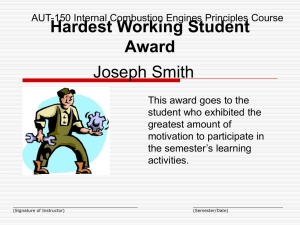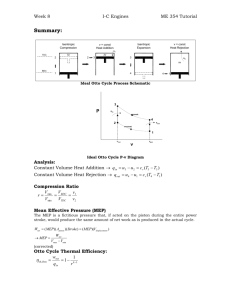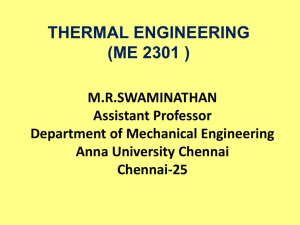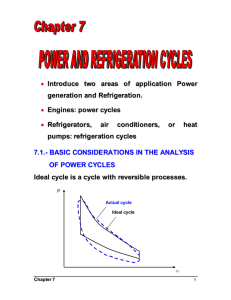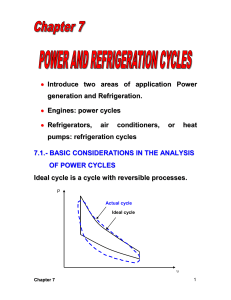Chapter 4
advertisement
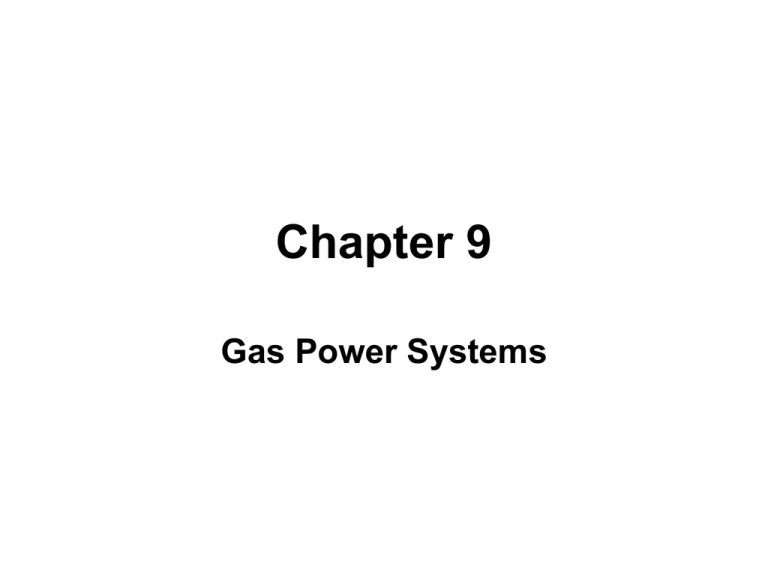
Chapter 9 Gas Power Systems Learning Outcomes ►Perform air-standard analyses of internal combustion engines based on the Otto, Diesel, and dual cycles, including: ►sketching p-v and T-s diagrams and evaluating property data at principal states. ►applying energy, entropy, and exergy balances. ►determining net power output, thermal efficiency, and mean effective pressure. Learning Outcomes ►Perform air-standard analyses of gas turbine power plants based on the Brayton cycle and its modifications, including: ►sketching T-s diagrams and evaluating property data at principal states. ►applying mass, energy, entropy, and exergy balances. ►determining net power output, thermal efficiency, back work ratio, and the effects of compressor pressure ratio. Learning Outcomes ►For subsonic and supersonic flows through nozzles and diffusers: ►demonstrate understanding of the effects of area change, the effects of back pressure on mass flow rate, and the occurrence of choking and normal shocks. ►analyze the flow of ideal gases with constant specific heats. Introducing Power Generation ►To meet our national power needs there are challenges related to ►Declining economically recoverable supplies of nonrenewable energy resources. ►Effects of global climate change and other environmental and human health and safety issues. ►Rapidly increasing demand for power owing to increasing population. ►Today we are heavily dependent on coal, natural gas, and nuclear, all of which are nonrenewable. Introducing Power Generation ►While coal, natural gas, and nuclear will continue to play important roles in years ahead, contributions from wind power, solar power, and other renewable sources are expected to be increasingly significant up to mid-century at least. Table 8.2 Introducing Power Generation ►This table also shows that thermodynamic cycles are a fundamental aspect of several power plant types that employ renewable or nonrenewable sources. ►Vapor power cycles are the focus of Chapter 8. In Chapter 9 gas turbine power systems and internal combustion engines are studied as thermodynamic cycles. The basic building block of gas turbine cycles is the Brayton cycle. ►Gas power system learning resources are now provided, including ►Power cycle review ►Area interpretations for work and heat transfer ►Ideal gas model review Power Cycle Review ►The first law of thermodynamics requires the net work developed by a system undergoing a power cycle to equal the net energy added by heat transfer to the system: ∙ ∙ ∙ ∙ Wcycle = Qin – Qout ►The thermal efficiency of a power cycle is W cycle Q in ∙ ∙ Power Cycle Review ►The second law of thermodynamics requires the thermal efficiency to be less than 100%. ►Thermal efficiency tends to increase as the average temperature at which energy is added by heat transfer increases and/or the average temperature at which energy is rejected by heat transfer decreases. ►Improved thermodynamic performance of power cycles, as measured by increased thermal efficiency, for example, also accompanies the reduction of irreversibilities and losses. ►The extent of improved power cycle performance is limited, however, by constraints imposed by thermodynamics and economics. Area Interpretations for Work and Heat Transfer ►Ideal cycles formed from internally reversible processes are used in Chapter 9 to further understanding of reciprocating internal combustion engines and gas turbine power systems. ►Closed systems involving expansion and compression work are used to model reciprocating engines. For these applications, the following area interpretations apply for internally reversible processes: Area Interpretations for Work and Heat Transfer W m int rev Q Tds m int pdv rev p T v s ►Observe that these expressions give work and heat transfer per unit of mass contained within the closed system. Area Interpretations for Work and Heat Transfer ►One-inlet, one exit control volumes at steady state are used to model gas turbine power plants. For these applications, the following area interpretations apply for internally reversible processes: p W vdp m int rev v T Q Td s m int rev s ►Observe that these expressions give work and heat transfer per unit of mass flowing through the control volume. Ideal Gas Model Review ►Elementary thermodynamic analyses of reciprocating internal combustion engines and gas turbines use ideal model principles, as reviewed in Table 9.1. Ideal Gas Model Review Ideal Gas Model Review Considering Reciprocating Internal Combustion Engines ►What are reciprocating internal combustion engines? ►They are reciprocating engines commonly used in automobiles, trucks, and buses. ►How do reciprocating internal combustion engines differ from the vapor power plants considered in Chapter 8 and the gas turbines considered in later sections of Chapter 9? ►Processes occur within reciprocating pistoncylinder arrangements rather than by mass flowing through a series of interconnected components. Considering Reciprocating Internal Combustion Engines – Two Types ►Spark-ignition ►A mixture of fuel and air is ignited by a spark plug. ►This type is • advantageous for applications up to about 300 hp (225 kW). • lightweight and relatively low cost. • predominantly used by automobiles in the U.S. Considering Reciprocating Internal Combustion Engines – Two Types ►Compression-ignition ►Air is compressed to a high pressure and temperature. ►Combustion occurs spontaneously when fuel is injected. ►This type is • preferred for high-power applications and when fuel economy is required. • used in heavy trucks and buses, locomotives and ships, and auxiliary power units. Introducing Engine Terminology ► Displacement volume: volume swept by piston when it moves from top dead center to bottom dead center Top dead center Stroke Bottom dead center ►Compression ratio, r : volume at bottom dead center divided by volume at top dead center Introducing Engine Terminology Four-stroke cycle Four strokes of the piston for every two revolutions of the crankshaft ►Intake stroke With the intake valve open, piston stroke draws a fresh charge into the cylinder. ► For spark-ignition engines, the charge includes fuel and air. ► For compression-ignition engines, the charge is air alone. Introducing Engine Terminology ►Compression stroke With both valves closed, piston compresses charge, raising the pressure and temperature, and requiring work input from the piston to the cylinder contents. ► For spark-ignition engines, combustion is initiated by the spark plug. ► For compressionignition engines, combustion is initiated by injecting fuel into the hot compressed air. Introducing Engine Terminology ►Power stroke The gas mixture expands and work is done on the piston as it returns to bottom dead center. ►Exhaust stroke The burned gases are purged from the cylinder through the open exhaust valve. Introducing Engine Terminology ►Smaller engines operate on two-stroke cycles with intake, compression, expansion, and exhaust accomplished in one revolution of the crankshaft. ►Internal combustion engines undergo mechanical cycles, but the cylinder contents do not execute a thermodynamic cycle – matter is introduced at one composition and is later discharged at a different composition. Introducing Engine Terminology ►Mean effective pressure, mep, is an important performance parameter. ►mep is a theoretical constant pressure that if it acted on the piston during the power stroke would produce the same net work as actually developed in one cycle. (Eq. 9.1) ►For two engines of equal displacement volume, the one with a higher mep would produce the greater net work, and if the engines run at the same speed, greater power. Simulating Reciprocating Internal Combustion Engines ►Detailed study of performance of reciprocating internal combustion engines requires consideration of complexities including: ►Combustion processes occurring within the cylinder. ►The effects of irreversibilities related to combustion, heat transfer, and friction. ►Heat transfer between the gases in the cylinder and the cylinder walls. ►The work required to charge the cylinder and exhaust the products of combustion. ►Accurate analyses of reciprocating internal combustion engines normally requires computer simulation. Air-Standard Analysis of Reciprocating Internal Combustion Engines ►To conduct elementary analyses of reciprocating internal combustion engines, simplifications are required. Although highly idealized, an air-standard analysis can provide insights and qualitative information about actual performance. ►An air-standard analysis has the following elements: ►A fixed amount of air modeled as an ideal gas is the working fluid. Ideal gas relations are reviewed in Table 9.1. ►The combustion process is replaced by heat transfer from an external source. Combustion is studied in Chapter 13. ►There are no intake and exhaust processes. The cycle is completed by a constant-volume heat transfer process while the piston is at bottom dead center. ►All processes are internally reversible. ►In a cold air-standard analysis, the specific heats are assumed constant at their ambient temperature values. Air-Standard Analysis of Reciprocating Internal Combustion Engines ►For reciprocating internal combustion engines, three cycles that adhere to air-standard cycle idealizations are the Otto, Diesel, and Dual cycles. These cycles differ only in the way the heat addition process that replaces combustion in the actual cycle is modeled: ►Otto cycle: Heat addition at constant volume. ►Diesel cycle: Heat addition at constant pressure. ►Dual cycle: Heat addition at constant volume followed by heat addition at constant pressure. Air-Standard Otto Cycle ►The Otto cycle consists of four internally reversible processes in series: ►Process 1-2: isentropic compression. ►Process 2-3: constant-volume heat addition to the air from an external source. ►Process 3-4: isentropic expansion. ►Process 4-1: constant-volume heat transfer from the air. ►The Otto cycle compression ratio is: V1 V4 r V2 V3 Air-Standard Otto Cycle ►Ignoring kinetic and potential energy effects, closed system energy balances for the four processes of the Otto cycle reduce to give W34 W12 u 2 u1 , u3 u 4 m m (Eq. 9.2) Q23 Q41 u3 u 2 , u 4 u1 m m ►The thermal efficiency is the ratio of the net work to the heat added: (Eq. 9.3) Air-Standard Otto Cycle ►Since the air-standard Otto cycle is composed of internally reversible processes, areas on the T-s and p-v diagrams can be interpreted as heat and work, respectively: ►On the T-s diagram, heat transfer per unit of mass is ∫Tds. Thus, • Area 2-3-a-b-2 represents heat added per unit of mass. • Area 1-4-a-b-1 is the heat rejected per unit of mass. • The enclosed area is the net heat added, which equals the net work output. Air-Standard Otto Cycle ►On the p-v diagram, work per unit of mass is ∫pdv. Thus, • Area 1-2-a-b-1 represents work input per unit of mass during the compression process. • Area 3-4-b-a-3 is the work done per unit of mass in the expansion process. • The enclosed area is the net work output, which equals the net heat added. Air-Standard Otto Cycle ►The compression ratio, r = V2/V1, is an important operating parameter for reciprocating internal combustion engines as brought out by the following discussion centering on the T-s diagram: ►An increase in the compression ratio changes the cycle from 1-2-3-4-1 to 1-2′-3′-4-1. ►Since the average temperature of heat addition is greater in cycle 1-2′-3′-4-1, and both cycles have the same heat rejection process, cycle 1-2′-3′-4-1 has the greater thermal efficiency. ►Accordingly, the Otto cycle thermal efficiency increases as the compression ratio increases. Air-Standard Diesel Cycle ►The Diesel cycle consists of four internally reversible processes in series: ►Process 1-2: isentropic compression. ►Process 2-3: constant-pressure heat addition to the air from an external source. ►Process 3-4: isentropic expansion. ►Process 4-1: constant-volume heat transfer from the air. ►The Diesel cycle has a two-step power stroke: process 2-3 followed by process 3-4. Air-Standard Diesel Cycle V1 ►The Diesel cycle compression ratio is: r V2 V3 ►The Diesel cycle cut-off ratio is: rc V2 Air-Standard Diesel Cycle ►Process 2-3 is heat addition at constant pressure. Accordingly, the process involves both heat and work. ►The work is given by (Eq. 9.9) ►Introducing Eq. 9.9 into the closed system energy balance for process 2-3 and solving for Q23/m gives (Eq. 9.10) Note: Enthalpy appears only for notational convenience and does not signal use of control volume concepts. ►The thermal efficiency is the ratio of the net work to the heat added: (Eq. 9.11) Like the Otto cycle, thermal efficiency increases with increasing compression ratio. Air-Standard Diesel Cycle ►As for the Otto cycle, areas on the T-s and p-v diagrams of the Diesel cycle can be interpreted as heat and work, respectively: ►On the T-s diagram, heat transfer per unit of mass is ∫Tds. Thus, • Area 2-3-a-b-2 represents heat added per unit of mass. • Area 1-4-a-b-1 is the heat rejected per unit of mass. • The enclosed area is the net heat added, which equals the net work output. Air-Standard Diesel Cycle ►On the p-v diagram, work per unit of mass is ∫pdv. Thus, • Area 1-2-a-b-1 represents work input per unit of mass during the compression process. • Area 2-3-4-b-a-2 is the work done per unit of mass in the two-step power stroke: process 2-3 followed by process 3-4. • The enclosed area is the net work output, which equals the net heat added. Air-Standard Dual Cycle ►By considering heat transfer to the air undergoing the power cycle as occurring in two steps: constant volume followed by constant pressure, the air-standard Dual cycle aims to mimic the pressure-volume variation of actual internal combustion engines more closely than achievable with the Otto and Diesel cycles. Air-Standard Dual Cycle ►The air-standard Dual cycle consists of five internally reversible processes in series: ►Process 1-2: isentropic compression. ►Process 2-3: constant-volume heat addition to the air from and external source. ►Process 3-4: constant-pressure heat addition to the air from an external source. ►Process 4-5: isentropic expansion. ►Process 5-1: constant-volume heat transfer from the air. ►As for the Diesel cycle, the Dual cycle has a two-step power stroke: process 3-4 followed by process 4-5. Air-Standard Dual Cycle ►Using closed system energy balances for each of the processes, the following expression for thermal efficiency for the air-standard Dual Cycle can be developed: (Eq. 9.14) Note: As for the Diesel cycle, enthalpy appears only for notational convenience and does not signal use of control volume concepts. ►Like the Otto and Diesel cycles, thermal efficiency increases with increasing compression ratio. Air-Standard Dual Cycle ►The specific internal energies and temperatures at each principal state are determined using methods similar to those used for the Otto and Diesel Cycles. ►Areas on the T-s and p-v diagrams of the Dual cycle can be interpreted as heat and work, respectively, as in the cases of the Otto and Diesel cycles. Actual Reciprocating Internal Combustion Engines ►As implied by the discussion of the Otto, Diesel, and Dual cycles, it is advantageous for actual reciprocating internal combustion engines to have high compression ratios. ►However, since the temperature of the fuel-air mixture being compressed in spark-ignition engines also increases with compression ratio, the possibility of autoignition or “knock” limits the compression ratio of such engines to the range 9.5-11.5, when fueled with unleaded gasoline. Actual Reciprocating Internal Combustion Engines ►Since only air is compressed in the cylinder, compression-ignition engines do not experience engine knock due to premature autoignition of fuel. Accordingly, such engines can ►operate at higher compression ratios than sparkignition engines. ►use less refined fuels having higher ignition temperatures than the volatile fuels required by sparkignition engines.
